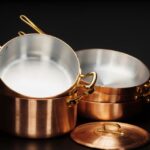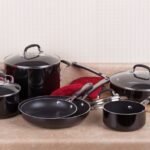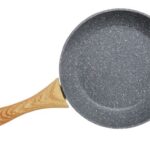About Soapstone
Soapstone (or steatite) is a bluish-gray rock, composed mostly of the mineral talc, which is rich in magnesium.
The use of soapstone is deeply engraved in the culture of Brazil, where locals have been using it to craft cookware for centuries now. Because of the high talc content, this rock is incredibly easy to work with. Furthermore, this soft mineral is what makes it quite durable and allows it to retain heat better than metals.
Soapstone Cookware
Soapstone cookware is a gorgeous, handcrafted type of cookware that’s great for cooking as well as for making your table look more appealing. It’s made of non-toxic natural material and can retain heat for much longer, compared to conventional metal cookware.
This type of cookware is suitable for making many delicious and healthy meals. However, to know how to get the most out of it, you need to learn more about it first.
Soapstone skillets, pots, bowls, and grills are made by hand from individual blocks of soapstone. This type of cookware has cooking properties similar to cast iron cookware. If you would like to cook a recipe that requires a cast iron pan, for example, know that a soapstone one would serve you well too.
Soapstone cookware is suitable for indoor and outdoor cooking. It can be used on the stovetop, in the oven, and on the grill. However, if you’re cooking on an electric cooktop, you should use a heat diffuser to avoid thermal shock.
Because it distributes heat evenly and isn’t prone to hot spots, this cookware is perfect for slow cooking. Thus, any pizza, risotto, and stew will likely taste much better when prepared in soapstone cookware. When preparing food in the oven, the soapstone will preserve it from succumbing due to extreme shifts in temperature.
The Advantages of Using Soapstone Cookware
1. Heat retention
Soapstone cookware offers incredible heat retention which helps keep your food warm for longer. In opposite to metal cookware, it has substantial thickness and density that enables it to retain heat for extended periods.
2. Great for presentation
Another advantage of soapstone cookware is that it’s perfect for food presentation. Because it is beautiful enough on its own, you don’t need to use separate serving dishes to make the table setup visually appealing.
3. Eco-friendly feature
Soapstone-made cookware is completely eco-friendly. It is great at keeping food cool or hot for longer periods, requiring less energy for cooking. The manufacturing process doesn’t include the use of any harsh chemicals. So, it doesn’t harm the environment in any way.
4. Non-stick property
Non-stick surfaces and cookware are incredibly popular, mostly because they’re easy to clean and great for preparing low-fat meals. Unlike other types of non-stick cookware, soapstone cookware isn’t coated with any potentially hazardous chemicals. Another great thing about it is that its non-stick surface makes cleaning super easy.
Disadvantages
1. Beware of thermal shock
Soapstone cookware is quite durable and can even handle temperatures of up to 1000 degrees Celsius. However, if it goes through sudden and extreme changes in temperature — it can crack. You should always preheat your soapstone cookware at lower temperatures and continue cooking without increasing the heat dramatically.
Additionally, to avoid cracks and damage, keep it away from direct flames.
Finally, never place the cookware under cold water while it is still hot — it will most likely break or crack.
2. It’s heavy
Soapstone cookware is much heavier than regular cookware, which could pose a problem if you have weak hands. If you drop a soapstone pan or hit it with something, there’s a good chance it will crack immediately. However, if you handle it with caution, there’s nothing to worry about.
3. It can get hot
Soapstone has great capability to retain heat. It stays hot for hours after we’ve removed them from the stove or the oven. You should handle hot soapstone pans and pots with care to avoid burning your hands and your table. Make sure to use potholders and have an insulated trivet on your table or countertop.
4. It is not completely inert
Soapstone cookware is not inert, and some minerals may leach into your food even after the seasoning process. The good news is that there are no hazardous chemicals that can negatively affect your health.
Preparing the Cookware for Use
Soapstone cookware needs to be cured with oil before you use it for the very first time. Once the oil penetrates the soapstone, the cooking surface becomes non-stick. The seasoning gives the cookware a smooth and beautiful appearance. After seasoning, the cookware is also longer lasting and easier to clean.
How to Cure Soapstone Cookware in Three Easy Steps
- Wash the cookware in hot water. Use a sponge or a brush to remove all the dirt, dust, and rock particles. Then, leave it to dry completely.
- Once it has had time to dry, grease the inside and outside of your cookware with cooking oil.
- To allow the soapstone to absorb the oil, leave the cookware in a warm place for 24 hours.
When curing stone lids, pans, and grills, there are a few additional steps you need to take:
- After 24 hours have passed, place the cookware in a cold oven and set the temperature to 350 degrees Fahrenheit.
- Turn the oven off after 15 minutes.
- Let everything cool down before removing the cookware.
On the other hand, if you’re curing pots:
- Set your stovetop at a low heat setting and fill the pot up to ¾ full with water.
- Keep increasing the heat to bring the water to a boil. Then, leave it to boil for 30 minutes.
- After removing the pot from the stovetop, let the water cool down to room temperature before drying it completely.
For deeper curing, you can go the extra mile and grease the cookware again. Then, bake it in the oven for 30 minutes at 375 degrees Fahrenheit.
What to Avoid
- To avoid damaging soapstone cookware, never place it while it’s still warm on a cold surface, and never heat an empty pot. You should also avoid cooking at high heat. Instead, gradually heat the cookware when you first start using it. This is a necessary precaution if you want to prevent thermal shock and damage.
- As soapstone cookware can’t withstand temperature fluctuations, you should avoid suddenly exposing it to lower temperatures. Instead, you should let it cool off naturally before placing it in the fridge, for example.
- Lastly, something to keep in mind with all types of cookware — never use sharp metal utensils for mixing and serving food. This is especially true for soapstone cookware, as these tools can easily damage the surface. Use silicone, plastic, or wooden ones to avoid scratches. If damage occurs, use fine-grain sandpaper to gently sand the scratches away, then re-season the cookware.
Cleaning
Soapstone cookware is quite easy to clean. Always let it cool down to room temperature and avoid using harsh detergents and abrasive cleaners. Most of the time, you won’t have to use anything stronger than warm water to clean it and a soft rag to dry it off.
After frying or sauteing foods in your soapstone cookware, you can use a bit of mild soap to clean the food residue. Once you have done it, dry it thoroughly and apply a small amount of oil to preserve the non-stick finish.
To remove more stubborn food residue, just pour hot water into the cookware, wait for about ten minutes, and then remove the residue with a non-abrasive sponge.




